On 18th July 1900 Mr. Smail wrote to Henry Hucks Gibbs. He addressed him by his title:
I am sending you herewith an album of views of Alianza Iquique, which I would ask
you to accept as a souvenir of our last but I hope not least among of Nitrate Oficinas.
The views were taken about the middle of last year1 (Fig. 1).
1.
"Letter to Lord Aldenham from Mr. Smail," 18th July 1900, in Oficina Alianza and Port of Iquique 1899, album 12, Fondo Fotográfico Fundación Universidad de Navarra/ Museo Universidad de
Navarra, Pamplona.
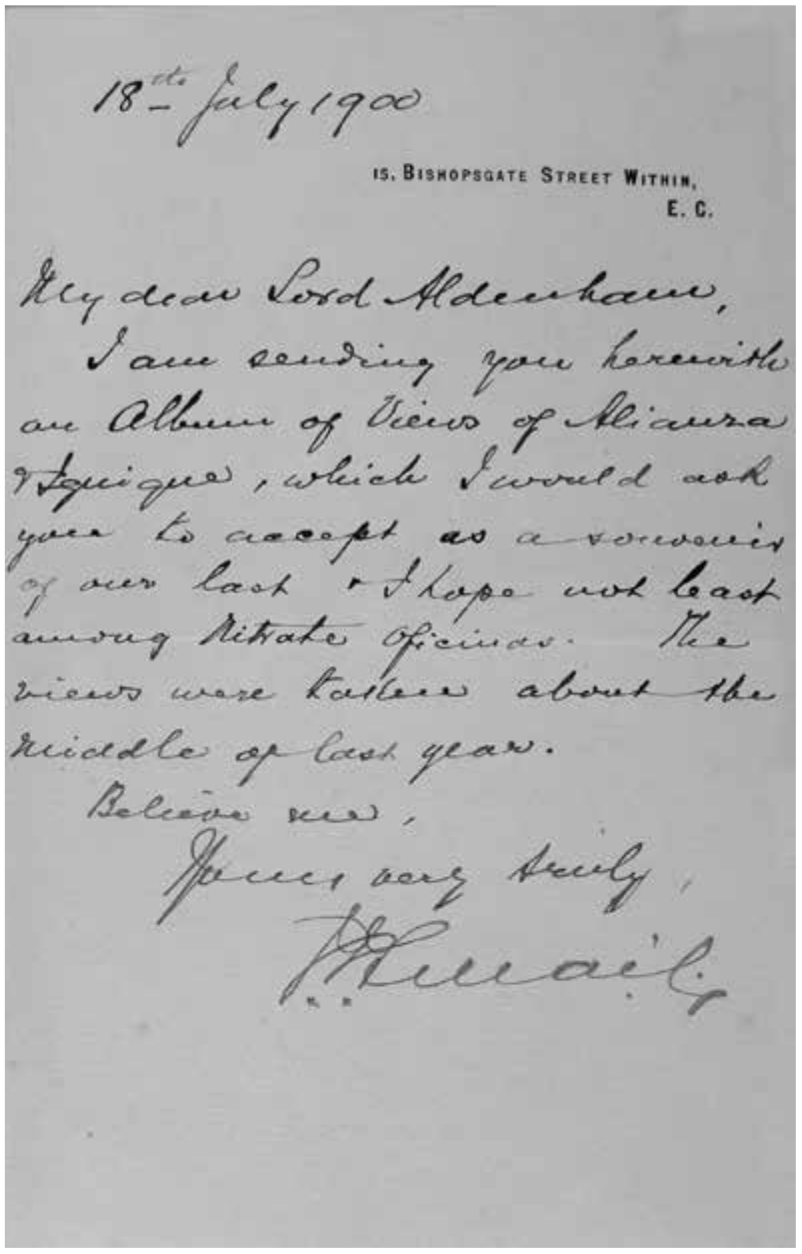
Mr. Smail was a manager of nitrate companies mining in Chile owned by merchant house
Antony Gibbs and Sons; he was accustomed to corresponding with their London office,
sending financial accounts to the head of the house (Fig. 2).2 The "Album of views," which has the title Oficina Alianza and Port of Iquique 1899 embossed on its cover, contains around 90 photographs of the nitrate industry in
the Atacama Desert of Chile, concluding with panoramas of the nitrate ports. The desert
was intensively mined for nitrate from the late nineteenth to the early twentieth
century. The industry was driven by British capital and investors that colonized an
inhospitable place, an almost waterless environment. Machinery was imported from Britain
and men to labor, Chilean, Bolivian and Peruvian, were brought and bound through an
enganche system to live in the nitrate Oficinas.3
2.
Manager's Report, Tarapaca Nitrate Company, Antony Gibbs and Sons Limited, London
Metropolitan Archives.
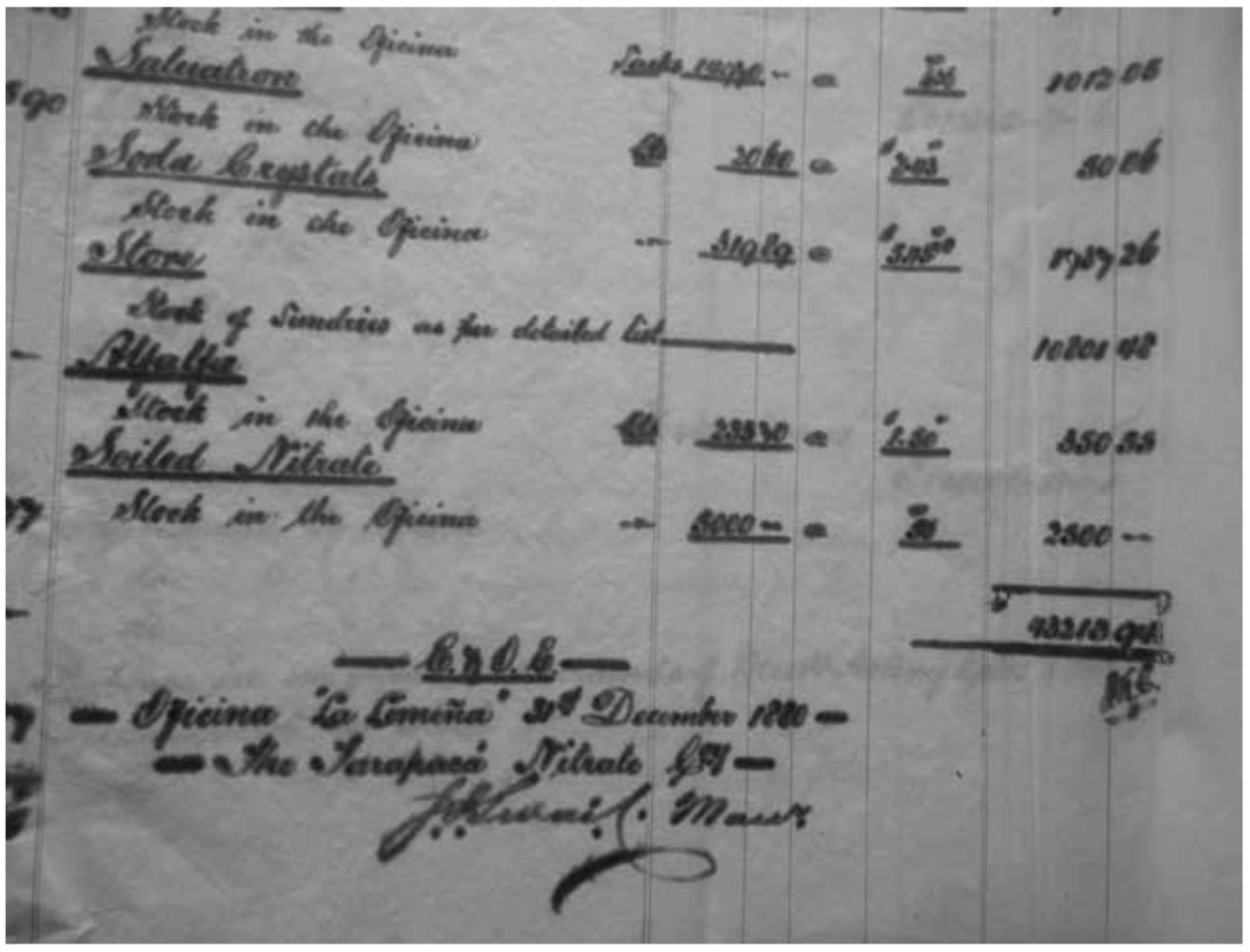
The Oficina Alianza and Port of Iquique 1899 album contains one image of contemporary political significance: the photograph numbered
27 (Fig. 3) presents a row of nitrate miners, shovels in hand, entitled "A Group of Desripiadores";
it has been deployed in commemorations of the Escuela Santa María massacre, when the
killing of hundreds of striking nitrate miners, railway workers, cart drivers and
artisans by government troops took place in Iquique on 21 December 1907. A week before,
5,000 nitrate workers had walked from the oficinas along the railway lines that cross the pampa to rally in Iquique; they waited in
the large courtyard of a school called Santa María while their representatives, including
José Briggs and Luis Olea, presented their demands: an end to payments in fichas, the nitrate company tokens that were the currency of the overpriced company stores;
wage stability with the establishment of an eighteen pence peso; safer working conditions, especially around cachuchos, the mechanism for crushing caliche, the desert rocks containing nitrate; honest working practices, particularly an end
to processing the low grade caliche for which workers had been refused payment; more schools and free evening lessons
for workers; an amnesty for strikers. The nitrate companies, merchants and bankers
refused to negotiate. Regional Governor intendente Carlos Eastman declared a state of siege and ordered nitrate workers back to the
pampa. When they refused, the military, led by General Silva Renard, used machine
guns to fire on the strikers and then charged at them with mounted troops and bayonets.
"Iquique, site of the greatest labour uprising, remains part of the class consciousness
of militant labourers" writes Michael Monteón.4 The Santa María massacre is, summarizes Lessie Jo Frazier, "the central symbol of
repression that led to the formation of working-class consciousness."5 It has been commemorated with annual rallies at the school and, most importantly,
recalled in song. The Cantana Santa María of Iquique was written and popularized during the 1970-1973 Popular Unity period. The 1907 killings
became a more complex symbol of class struggle in Chile: "an allegory for the overthrow"6 of Salvador Allende's government by General Pinochet with his United States supporters.
3.
"Group of Desripiadores," in Oficina Alianza and Port of Iquique 1899, no. 27.
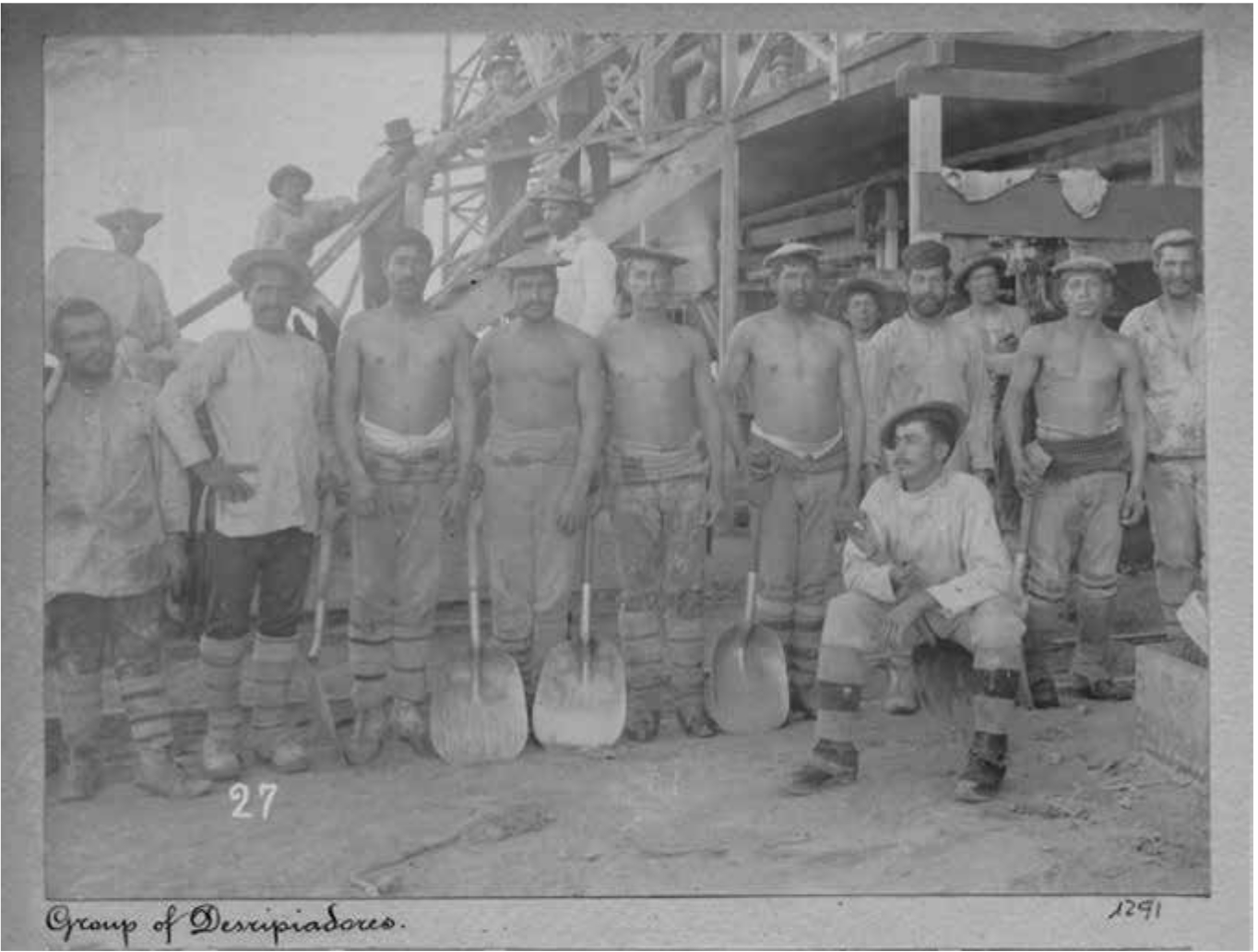
The figures of nitrate workers photographed some eight years before the Santa María
massacre are an embodiment of the heroism of manual labour, collectively organized.
Their forms circulate far beyond their position in the Oficina Alianza and Port of Iquique 1899 album;7 they have been remodelled in metal, digitally reproduced on Left radical blogs as
well as used to represent the regional history of Iquique to tourists (Fig. 4). The image is arresting (Fig. 3); it offers the possibility of catching a glimpse of the work behind nitrate mining,
of the experience of shovelling the desert earth, of the material conditions of laboring
in the desert: a flash8 of a past reality. It contains, in Walter Benjamin's words, a "tiny spark of contingency":
No matter how artful the photographer, no matter how carefully posed his subject,
the beholder feels an irresistible urge to search such a picture for a tiny spark
of contingency, of the Here and Now, which reality has so to speak seared the subject.9
4.
Box of Biscuits from local Iquique shop, 2012.
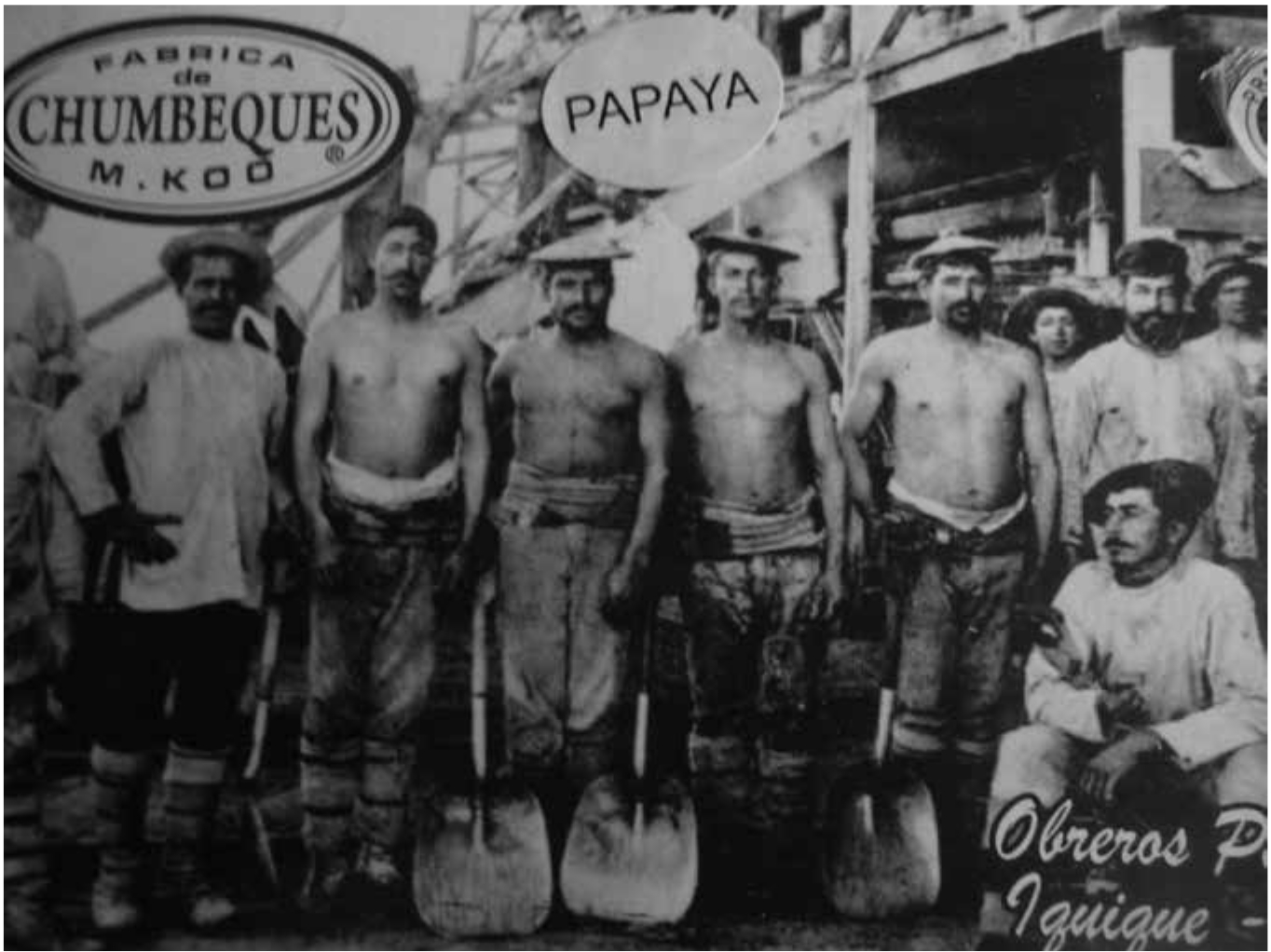
Maybe. Hopefully. We shall see. This analysis examines the Oficina Alianza and Port of Iquique 1899 album as a fragment of an archive of the British nitrate industry in Chile. I offer
a reading of its sequence of photographic images. Space allows pausing upon only a
few of the 90 images to consider photographic practices used to record the mining
exploitation of Atacama Desert.10
The first image, the number 1 scratched onto its surface, is, I would suggest, one
of the most important of the album (Fig. 5). Initially, it might appear rather blank: an empty sky, pale sepia produced by colodion
printing process, hangs over a flat desert, which is only a little darker in colour.
The rocky surface creates some shadow. The nineteenth century camera has captured
details of surface. The earth has texture but, with its emptiness, the sky moves to
the foreground beneath and below it. The railway tracks established lines of perspective
along the left of the image; the right hand track, a long straight line with a dark
sharp shadow, propels the viewer towards a building and then a wall. Also distinguishable
because its shape is darker, straighter than the surface of the desert, a wall cuts
across the horizon where the desert fades into the sky, providing another line of
sight through a series of structures that continue to draw the viewers attention across
the image towards a distant factory building. Entitled "General View of Grounds and
Works" (Fig. 6), the image prepares the viewer for the following 90; it sets the scene, indicates
everything that is in store.
5.
"Series of Open Trenches," Oficina Alianza and Port of Iquique 1899, no. 7.
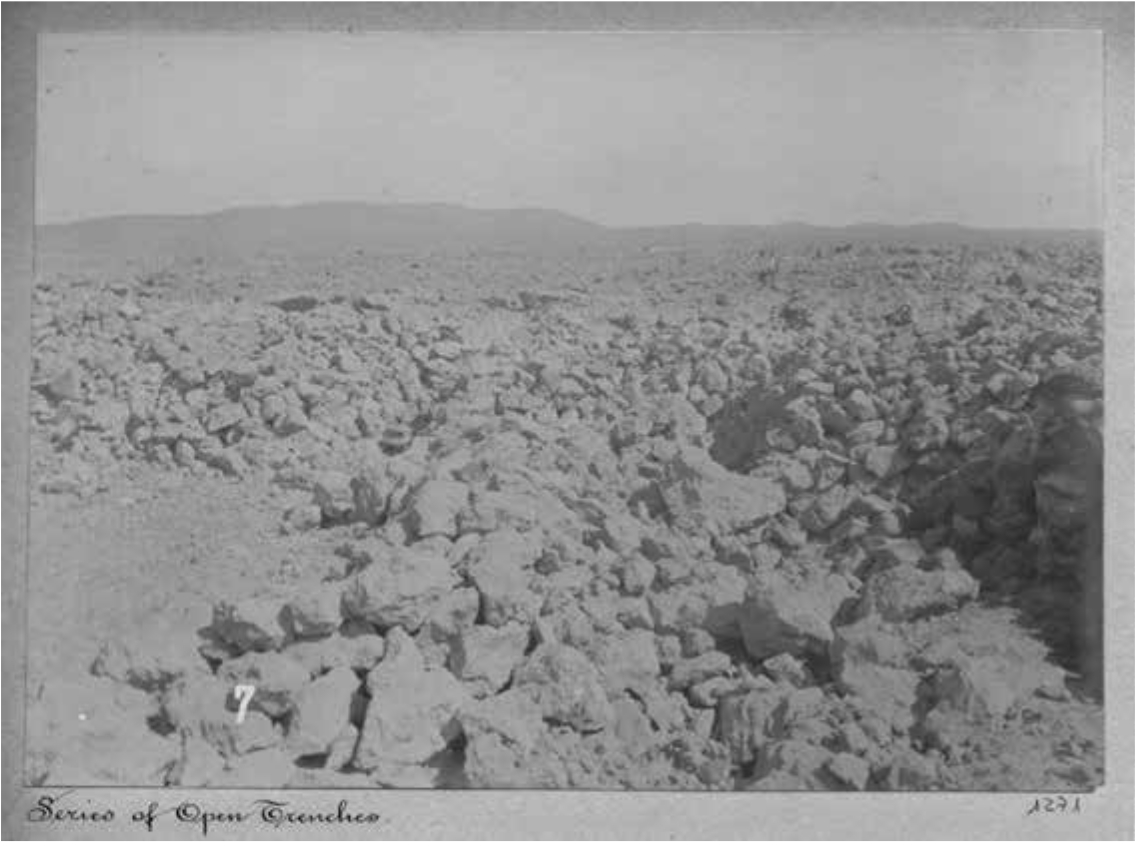
6.
"General View of Grounds and Works," Oficina Alianza and Port of Iquique 1899, no. 1.
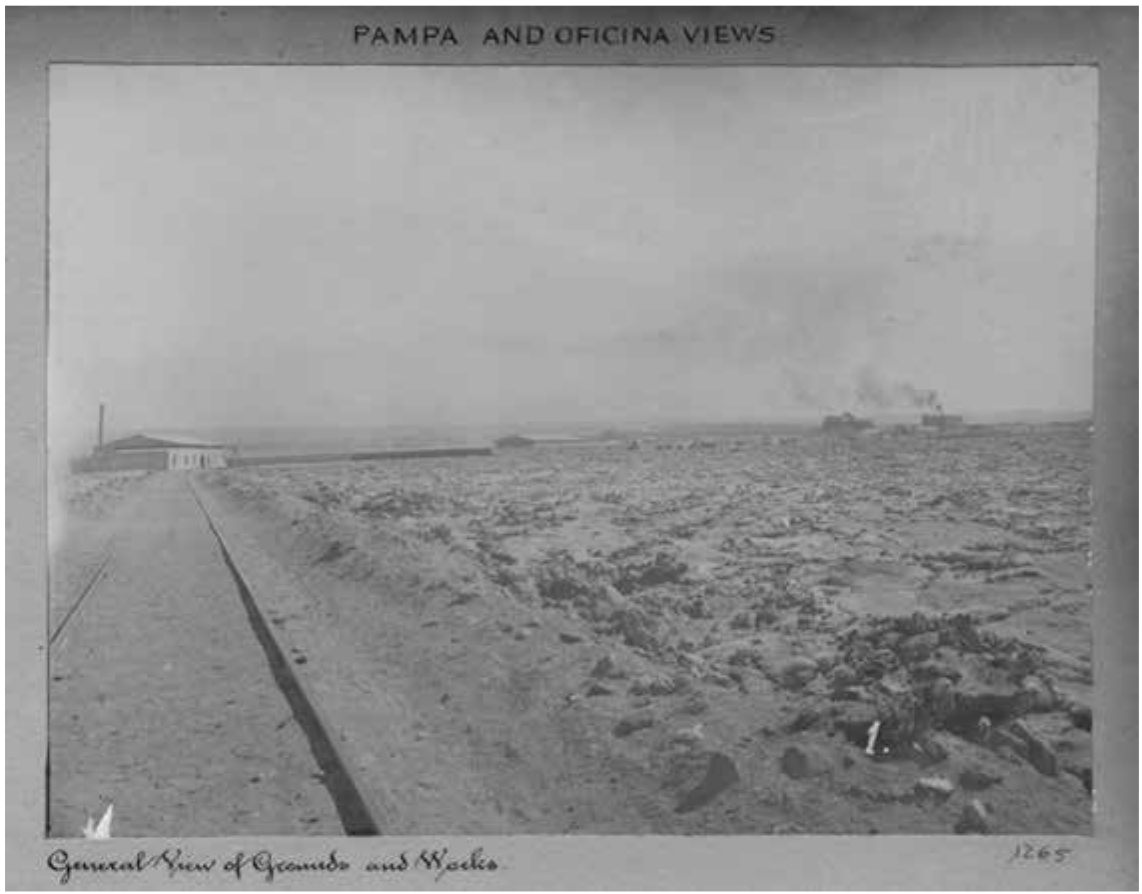
Rather than blank, the empty, flat image is full and quite dynamic. The railway tracks
generate a geometrical order; the lines square off the desert. The view's photographic
arrangement posits an industrial topography; it shows a worked and controlled landscape.
Within a measured boundary, the desert's uneven surface becomes a nitrate field, one
of the "Grounds" of industry, to use a word taken from the image's written title.
Tracks and walls are furthermore, lines of movement, visual and geographical trajectories.
Their destination, on the far right of the horizon is the Oficina. Its smoking chimney,
a sign, or more precisely, an index of industrialization (Fig. 6). The viewer's visual path simulates that of the train, on which the photographer
carrying his camera and other photographic paraphernalia would certainly have travelled.
Train and photographer, with those who have flicked through the album trailing behind
them, are heading for the Oficina. The opening image promises a journey and, indeed,
a journey does unfold through the album.
The first 40 photographs trace the mining, processing and transport of nitrate; its
transformation from desert rock, a mineral deposit, caliche, lying just beneath the surface, to a chemical, bagged and ready for transport (Figs. 7 and 8). As nitrate changes its material state, it crosses the landscape: each photograph
shows an industrial stage and is a geographical frame. When the nitrate is loaded
onto the train to leave the desert (Fig. 8), the camera's movement and the viewer's gaze behind it, rest on the Oficina itself.
A tour of the nitrate works and nitrate town in 20 photographs opens with a view of
the general stores and concludes with one of the administrator's house (Figs. 9 and 10). This sequence is an interlude. The image that immediately follows, the selection
of which seems to use editing techniques that characterised early moving film, shows
the arrival of the train pulling sacks of nitrate to the port of Iquique (Fig. 11). It is as if the nitrate town tour took place while the bags of nitrate were travelling
across the desert to Iquique. Geographical frames are also time frames. When the train
enters Iquique, the viewer joins nitrate's journey. The next sequence, ten or so photographs,
tracks the movement of nitrate as it is transferred from vehicle to vehicle, stack
to stack, from train to warehouse, warehouse to dock, boats to ships (Figs. 12 and 13). Here is evidence of its export, a measurement of the quantity of nitrate. The effect
of the images is cumulative: piles upon piles of stock are a display of abundance,
always a representation of wealth.
7.
“Loading Trucks for Transport to Iquique,” Oficina Alianza and Port of Iquique 1899, no. 39.
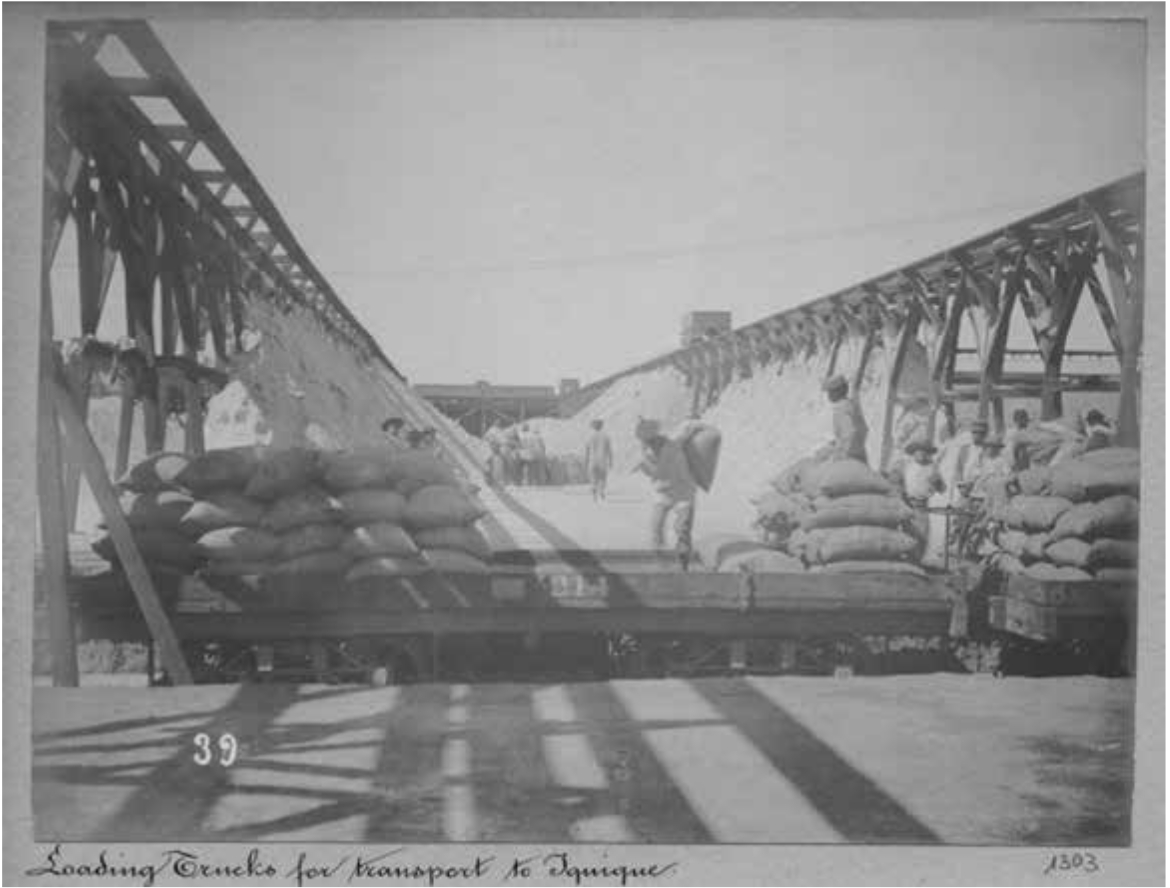
8.
“Leaving Works for Port,” Oficina Alianza and Port of Iquique 1899, no. 40.

9.
“General Stores,” Oficina Alianza and Port of Iquique 1899, no. 44.
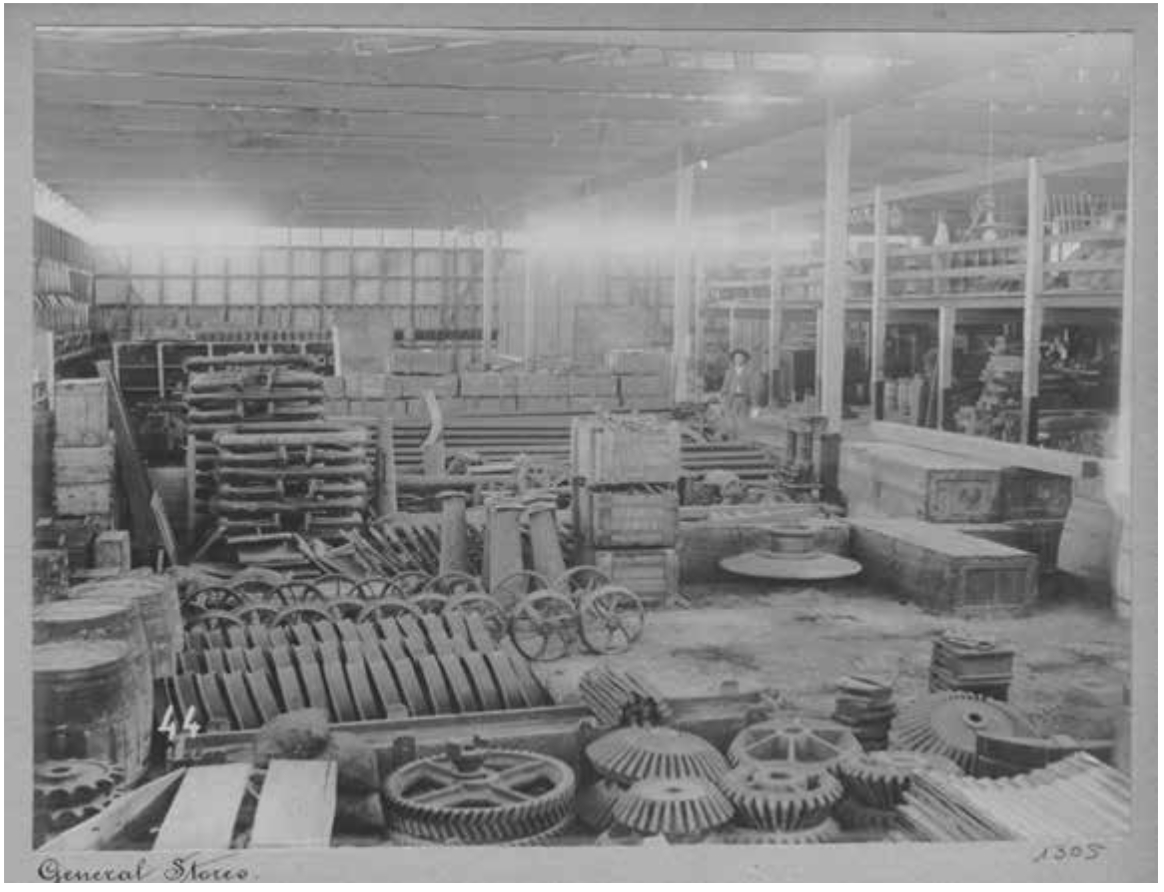
10.
"Exterior of Administration House," Oficina Alianza and Port of Iquique 1899, no. 71.
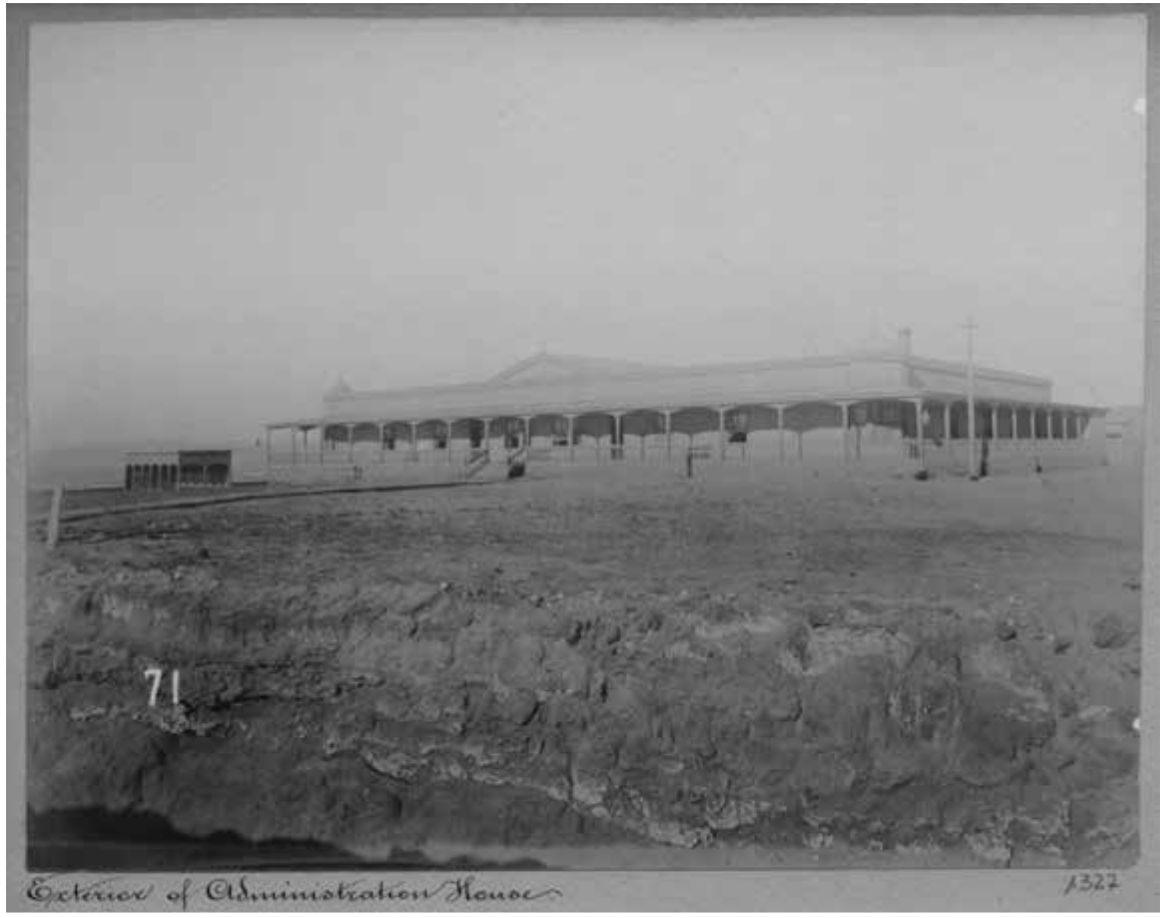
11.
"Arrival of Nitrate Train in Iquique," Oficina Alianza and Port of Iquique 1899, no. 76.
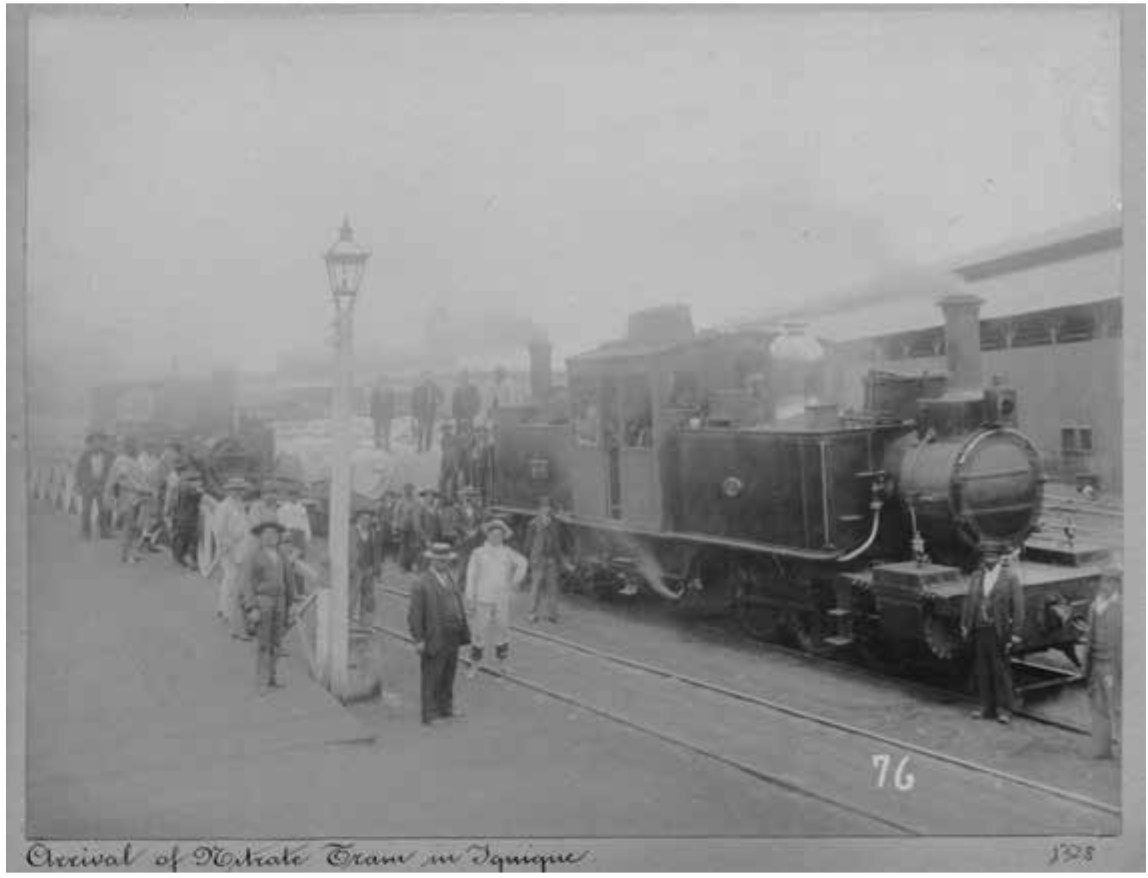
12.
"Warehouse Interior. Loading a Car for Shipment," Oficina Alianza and Port of Iquique 1899, no. 79.
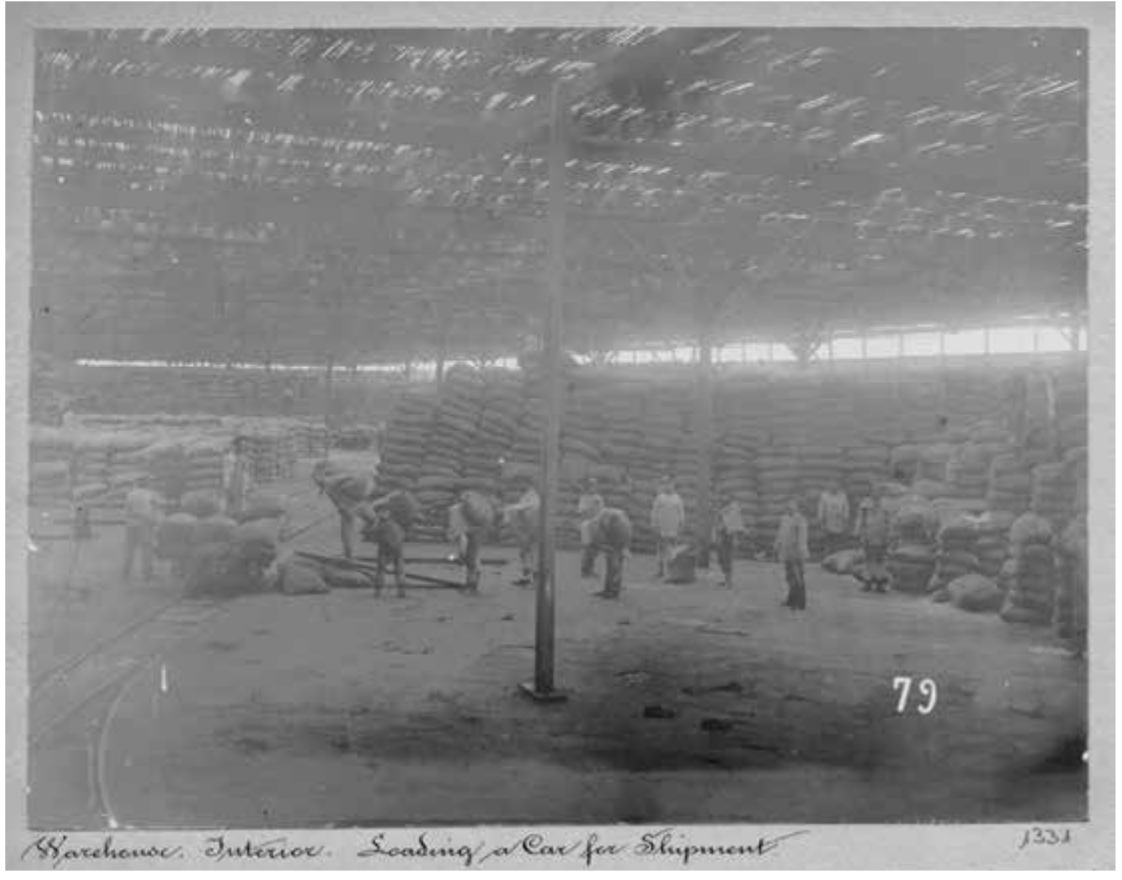
13.
"Pier for shipping Nitrate into Lighters," Oficina Alianza and Port of Iquique 1899, no. 81.

The album Oficina Alianza and Port of Iquique presents a photographic sequence that is spatial, material and temporal: from the
desert to the sea, from rock to commodity. Furthermore, there is an evocation of historical
time within the sequence that makes industrial process appear as historical progress.
It is the second image of the album-that which immediately follows the opening photograph
of a worked controlled desert landscape, an industrial topography- which opens the
historical sequencing. Entitled "Virgin Nitrate Grounds," it is almost featureless,
a photograph of nothing, no event, no action (Fig. 14). It consists of two blocks of colour: a pale earth and an even paler sky. It displays
the desert as vast empty expanse, an uninhabited land, waiting for something to happen.
The human figure is scaled small against the desert to demonstrate its emptiness and
readiness. Two men on horses are positioned in the centre of the photograph; their
forms are indistinct; only an outline is discernible. The horses are held (one by
the reins) facing each other, angled to form a gateway into the desert vanishing to
a point between them. Across from each other, the men look into the distance. The
profile of their clothed bodies, the shape of their hats not their faces visible,
indicates they turned away from the camera, encouraging the viewer to gaze as far
as their eyes can see, to the vanishing point. The undisturbed surface of the empty
desert spreads out before them. In this geographical time frame, there is no smoking
chimney, no signs of industry. In the photographer's time, real time, if you like,
he has simply pointed his camera away from the Oficina Alianza, the fully operational
Oficina, that he was heading towards as he travelled on the train. He has produced
another view of the desert seen as the Oficina's past; thus his sequencing of photographs
becomes an account of the desert's industrialisation; it shows the industrial transformation
of the Atacama desert as a historical as well as daily operation.
14.
"Virgin Nitrate Grounds," Oficina Alianza and Port of Iquique 1899, no. 2.
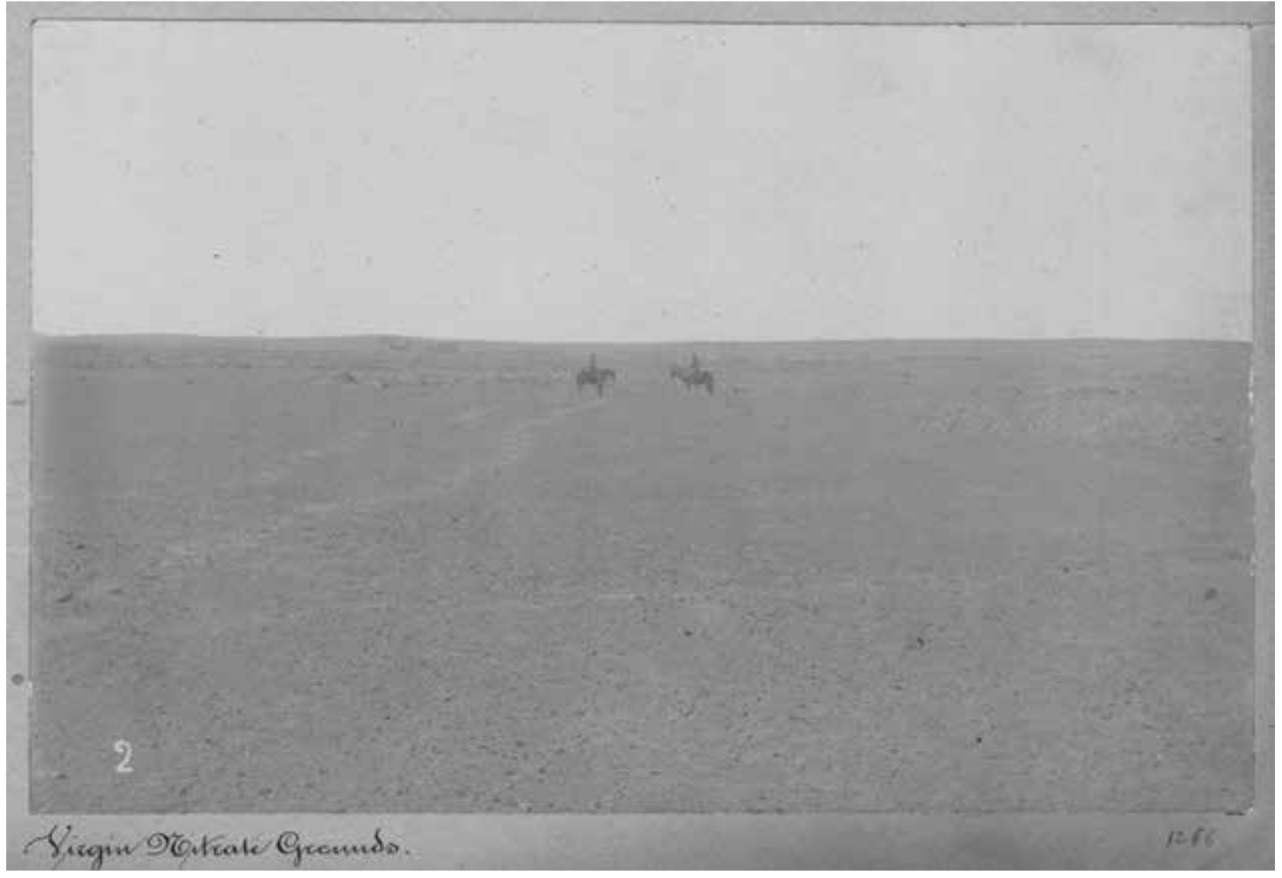
In the album, the desert landscape dominates (expansive ochre fields under large empty
skies), until the arrival of technology. The album's seventeenth frame is a well-organised
image of industry (Fig. 15). The tracks, girders and planks (the railway carrying carts of caliche and regular openings of the crusher's hopper) extend from bottom left to centre providing
lines of perspective around which the image's elements are drawn into symmetry and
balance. Steep sided structures, exposed constructions reproducing metal forms, rise
on either side of the tracks. Industry lies between, represented by activity and quantity,
productivity, to use a term taken from Economics. Men engage in purposeful stances
within the industrial architecture and oversee mounds of materials. At the very centre
of the image, where lines of perspective converge, is its defining moment, a stage
for the industrial process' announced by the title: "Top of Caliche Hopper Carts tipping
Caliche." Three men reach and hold the cart as dusty rocks pour from the bottom and
spill from the top (Fig. 16). The foremost figure's face, whose leaning body is aligned with the cart to become
part of the shape and movement of the tipping caliche, is turned upwards towards the
camera. His glance punctures the image, alerting its viewers, us, that this moment
is being presented. But the image's other elements combine to encourage the dismissal
of his stare, and the challenge it implies, in favour of the documentary requirements
of nineteenth century industrial photography. The cart and its handlers might have
paused for the camera but the heavy loads stacked behind them ratify that the sight
of a tipping cart of caliche is routine in nitrate processing, in fact, it is repeated in the image: a dust cloud
pours from a mule drawn cart, positioned above right. The viewer can see enough to
assume that this happens often.
15.
“Top of Caliche Hopper Carts tipping Caliche,” in Oficina Alianza and Port of Iquique 1899, no. 17.
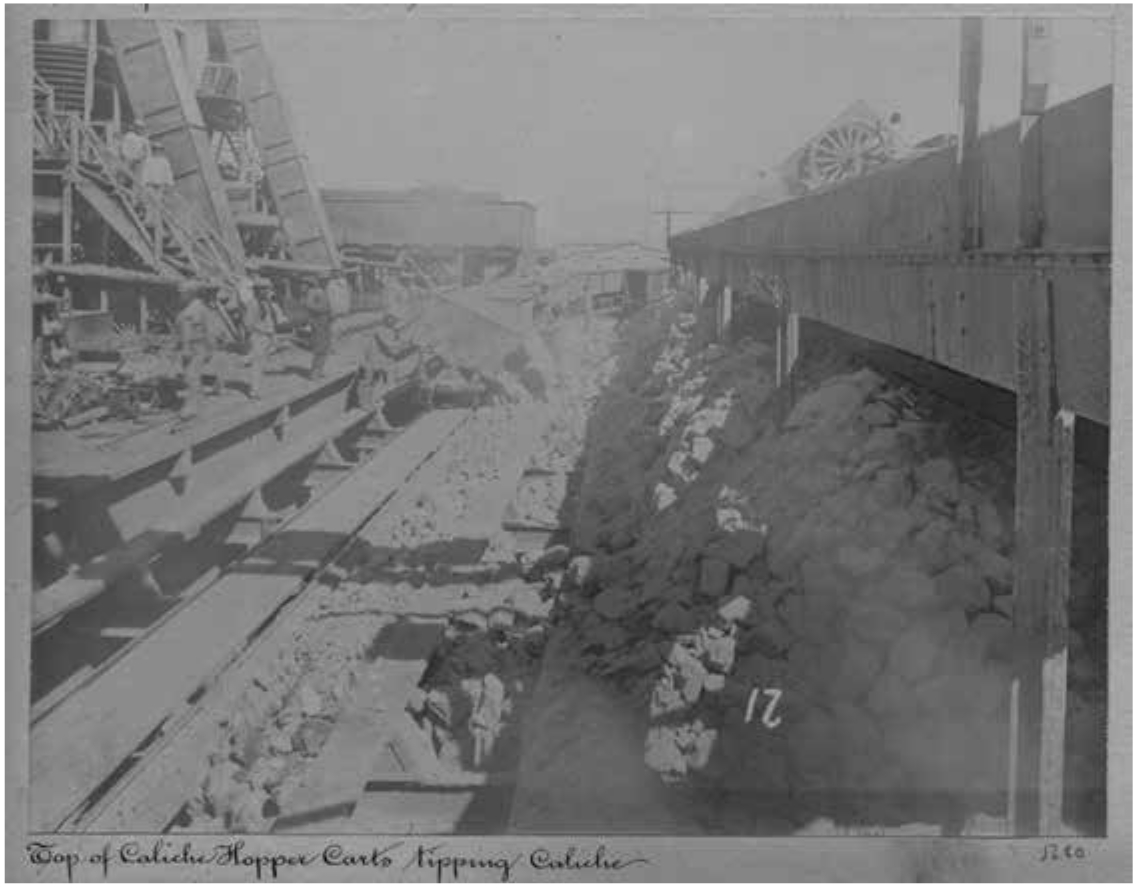
16.
“Top of Caliche Hopper Carts tipping Caliche,” detail. 110
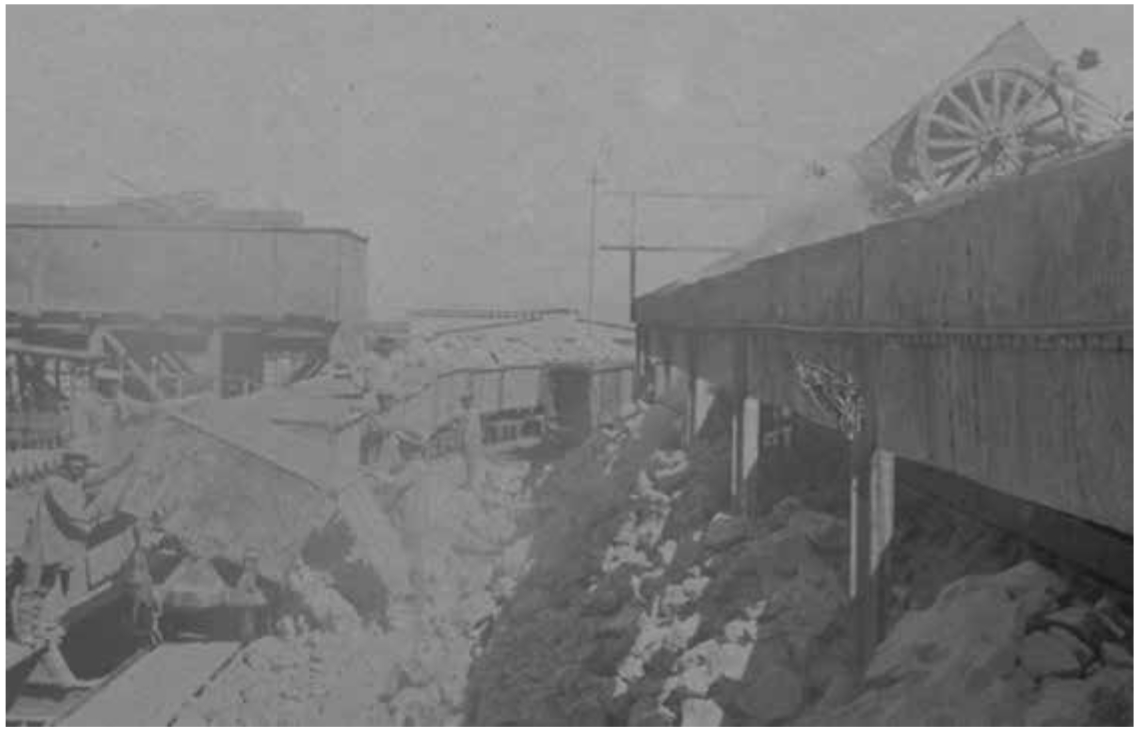
These moments in the journey of nitrate are not merely a record of where the photographer
stood nor is the narrative of nitrate his invention. I am assuming the photographer
is male, though I do not know his name and have no other sign of his identity. Records
of him have unfortunately been lost or overlooked; his anonymity is an historical
accuracy of a kind. The photographer of Oficina Alianza and Port of Iquique 1899 cannot be distinguished as an individual practitioner because his work reproduces
standard photographic forms of the late nineteenth century. The sequencing of images
was created through considerable careful editing, their numbering and renumbering
is discernible on some plates (Fig. 15), but the composition of the views of the desert landscape and nitrate industry dutifully
follows the conventions of late nineteenth century photographic practices. The extraordinary
spaces of the Atacama Desert are presented as an industrial scene, like other industrial
scenes. The desert is framed through the practice of industrial photography, which
was well established by the time the album was compiled in 1899. The historian of
the art of the engineer, Francis Pugh, states:
During the latter half of the nineteenth century industrial photography became one
of the principal means for recording and publicizing the achievements of British industry,
so that by 1900 there was hardly an industrial sector which did not make use of photography
in one form or another11
It was from the mid-nineteenth century on when photographers with some professional
status were commissioned by engineers or contractors, to produce photographic records
of large-scale industrial schemes. Typically, it was ambitious structural interventions
on landscapes that were documented, such as bridges or tunnels for railway lines.
Henry Flather's Construction of the Metropolitan and District Railway (Fig. 17) is an important example of this photographic practice. Many of Flather's 64 images
contributed to the establishment of the conventions of industrial photography; I would
draw attention to just two images. One, Figure 17, is a perfectly arranged scene of industry. Flather deploys pictorial practices to
provide a frame through which industry can be represented; he organizes the view of
industry, brings order to the disorder of an unfinished industrial work. His photograph
has the formal arrangement of a landscape painting:12 a left to right, top to bottom axis creates movement across the picture plane. On
either side of this axis, the railway cutting across and the subject of the photograph;
alongside exposed surfaces of dark dug out earth and lighter rocky shelves lie heaps
of stuff, piles of wooden planks awaiting use, barrows of blocks ready to be carried
away. An unfinished scene is drawn into a balanced arrangement. A symmetry between
two cranes suggests an archway. The heaps of temporarily discarded stuff form geometrical
patterns, repeating rectangles or the lines of isosceles triangles. The incomplete
nature of the scene is busy but not chaotic; it is an image of the moment of material
transformation. Human figures hold a small part in this scene; they stand within its
industrial structures, as if emplacements, belittled by the amount of materials and
the scene's dimensions and scale.
17.
Henry Flather, The Construction of the Metropolitan District Railway, 1866, © Museum of London.

Another image of the Bayswater Excavations by Flather is captioned A gang of workmen around a steam crane which is removing spoil from an excavation
at Craven Hill (Fig. 18). It has the human figure, the worker's body, a group of laboring men, as its subject.
They are turned to face the photographer, the camera and, once the shapes of light
upon photographic plate are fixed in chemicals and reproduced, they face us, the photograph's
viewers. They have been positioned ascending and descending the steam crane, another
balanced classic painterly arrangement. The figures form sight lines from the left
and right that move towards the center of the image, to the pulley mechanisms, cogs
and wheels, the steam pipe atop it all, the pinnacle of the image. The group of laboring
men presents the technology of industrial work and themselves; the poses their bodies
hold can be read as industrial labor. The foreman positioned center right holds out
his chest and fills out his waistcoat to demonstrate his authority. The white jacketed
workers' stance, front leg bent, shovel held, back leg straight, does not simply display
his type of manual work but also his readiness to work. The group of laboring men
are not shown with their backs bent in labor (another trope of industrial photography).
We see they have stopped to be photographed, but labor is the photograph's subject,
as it is also represented in the Oficina Alianza and Port of Iquique album's 27 image (Fig. 3).13
18.
Henry Flather, A gang of workmen around a steam crane which is removing spoil from an excavation
at Craven Hill, Bayswater Excavations, 1866-1868, © Museum of London.
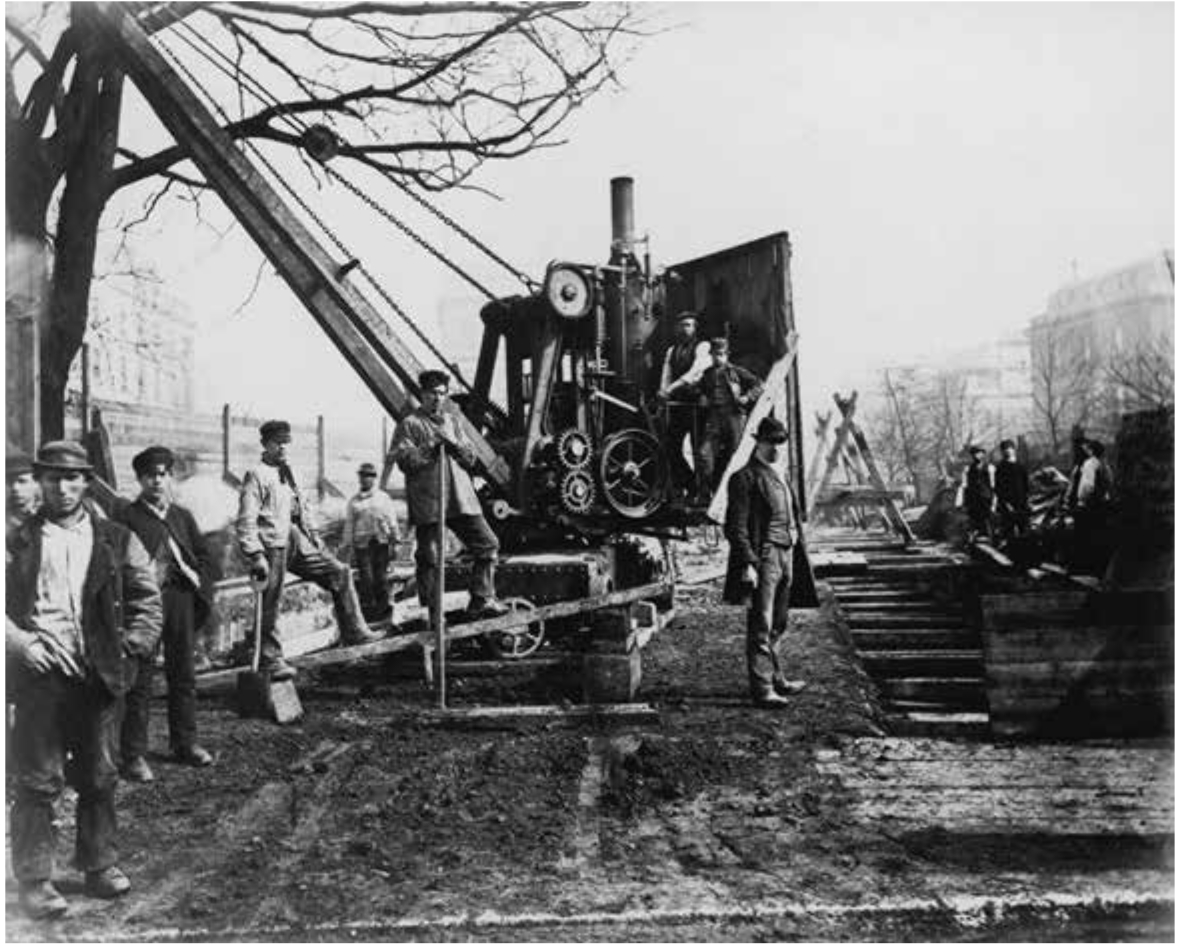
A row of nine nitrate workers confronts the viewer. They do so because they have been
lined up directly in front of the photographer and have held their positions. The
figure on the far left is posed as for an individual portrait: his gently angled body
weighted on his back foot, his face and glance tilted upwards, he carries a token
of his identity, the shovel (Fig. 19). The rest of the row of nitrate workers has simply faced the camera: a full-length
frontal view of their entire body is plainly visible: legs straight, arms to their
sides, faces looking forward. They appear to await a military inspection; nitrate
workers on display. Yet, they do not entirely present themselves. Their presentation
is arranged within the image, through the photograph's composition. The row of workers
is mediated by a single figure in the foreground (Fig. 20). Seated on his shovel, beneath eye level, he does not block out the view of the
nitrate workers; moreover, to use metaphors stemming from performance, he announces
them. In the background there are nine figures (Fig. 3). Their faces less distinct, their bodies partially visible, they fade into the image's
architecture. Five figures with the smaller frame of a child are evenly spaced ascending
wooden stairs, and function as supporting cast to the main players. Five of a row
of nine nitrate workers are bare-chested and four stand together in the middle. If
the row is the main performance; they are its centerpiece. All other nitrate workers
are fully clothed in every other image in the album. Desripiadores, those shoveling waste of nitrate processing from boiling tanks, worked with their
shirts off. One female North America observer, Mabel Loomis Todd, noted they were
half-naked.14 Perhaps, then, in a moment of rest from work prompted by the act of photography (the
interruption of their routine by the photographer's arrival, the installation and
adjustment of his equipment), some men cooled and dressed, or others felt the heat
of the day and undressed. Two white shirts hang over the wooden structures supporting
the Oficina's boiling tanks, the collar-less one, a worker's garment, just visible.
Unintentional or otherwise, this is a show of strength: physical, manual, masculine.
That much can be seen but its meaning is not clear, neither in 1899 nor now. Classical
and primitive subjects wear bare chests in all kinds of imagery from sculpture to
comic strips: ancient warriors and colonial peoples.
19.
"Group of Desripiadores," detail.
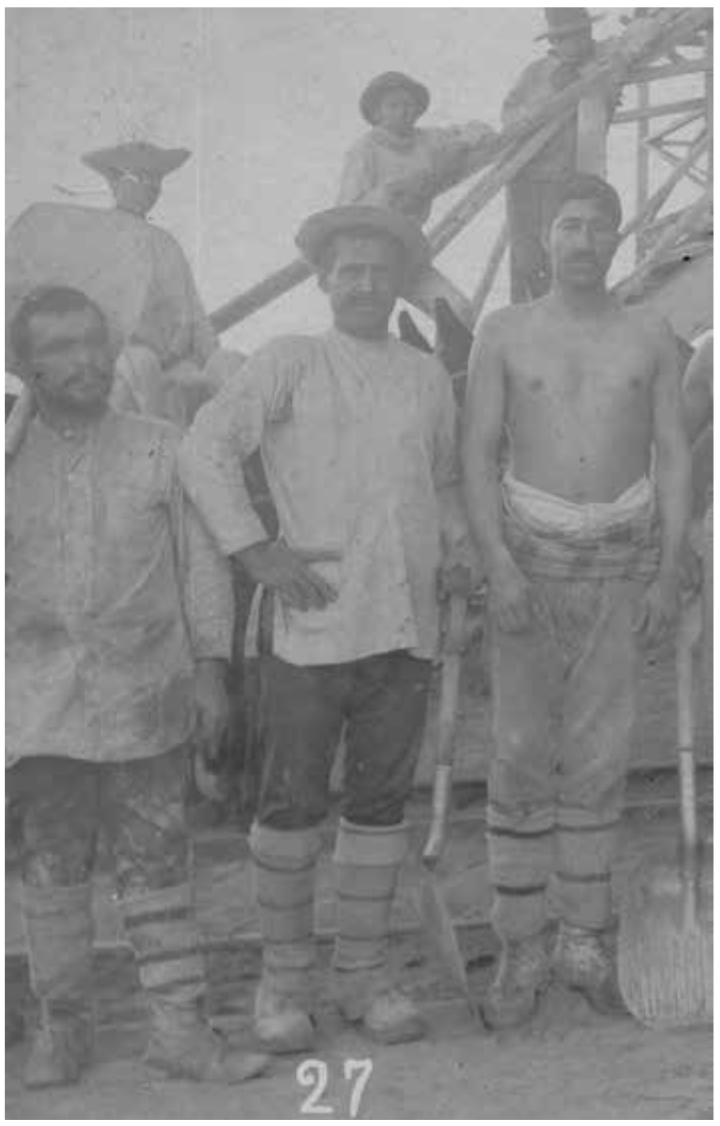
20.
“Group of Desripiadores,” detail.
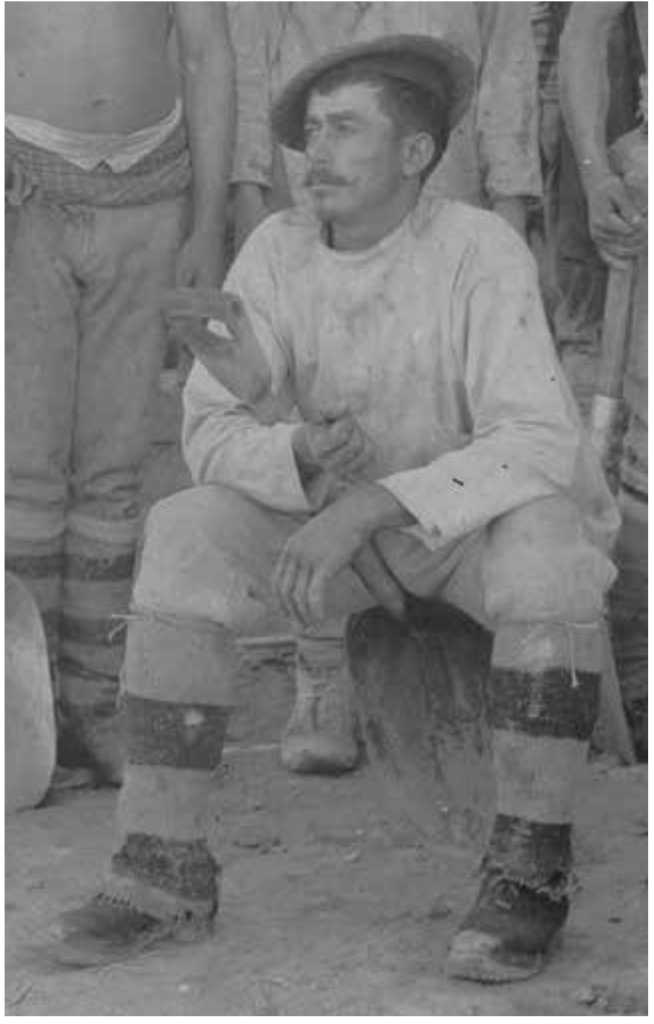
To try to understand the contradictions of such a show of strength, I would like to
consider that moment of interruption, the act of photography. When the photographer
was ready to take his shot, did he fear asking the nitrate workers to appear fully
dressed? Or, did they reach for their shirts and he told them to stand for the photograph
without them? In that moment, to whom did their strength belong? There are two figures
who do not stare at the photographer or at his camera but look to their left: the
seated figure in the foreground and an upright figure parallel to him, behind the
row of nitrate workers. They seem to be looking at the same thing or the same person;
they wait for the photograph to be taken, the moment to pass, to then perhaps receive
a sign from the foreman, el capataz, to get back to work.
Like Flather's Bayswater Excavations photograph, the "Group of Desripiadores" is an
image of work arrested, but industrial labor is its subject. I am not arguing that
the photographer of Oficina Alianza and Port of Iquique had seen Henry Flather's photographs or admired the work. My proposal is that by
1899, when he arranged his tripod on the uneven surface of the rocky desert to point
his heavy camera towards an empty landscape before turning to focus upon the operations
of machinery, a way of picturing industry was already in place. Furthermore, by the
1880s, according to Francis Pugh, photographic documentation of industrial works had
become part of that industrial work, organized by the engineer, contractor or company
carrying it out. At this time, he states "the engineer-photographer becomes a more
familiar figure."15 The photographer of the album is just another industrial worker,16 and the less we know about him, his relationship to the nitrate companies, the owners
of the machinery or the railway, the more the photographs appear to record the historical
inevitability of industry, that the desert was there just waiting to be industrialised,
rather than his own existence which was contingent upon industrial relationships.
Each industrial stage of nitrate mining at the Alianza Oficina documented in its album
was "entwined" with,17 even determined by, competitive relationships of accumulation of capital. If it is
not a contradiction in terms, nitrate trafficking was a matter of competing monopolies.
Following Chile's victory in the War of the Pacific over neighbours Peru and Bolivia,
the natural monopoly of sodium nitrate of the Atacama Desert became the site of concentrated
capitalist exploitation. Competition for concessions to mine nitrate fields and the
railway routes from these desert fields to the Pacific ports led to the rapid expansion
of nitrate mining and the industrialisation of the Atacama. One nitrate company, for
instance (that owned by Antony Gibbs, John Thomas North, Balfour Williamson, Campbell
Outram and Folsch Martin) worked several nitrate fields and owned the nitrate Oficina
and warehouse in Iquique or Pisagua where sacks of stored nitrate awaited export to
Liverpool, London and Europe. German farmers, who grew beets for cattle feed and liked
the quickening effect of nitrate fertilizers, were important customers. The railways
that transported nitrate from the desert to the sea were the "key" to profits and
profiteering in nitrate.18 Railway companies charged nitrate companies for transportation. Monopolies reigned.
High tariffs were charged per quintal (close to an American hundredweight) of nitrate.
In 1887, British engineer turned financial speculator John Thomas North, bought 7,000
shares in the Nitrate Railways Company, a Peruvian firm owned by the Montero brothers,
but registered in London in 1882. The following year, North became company director.
Herbert Gibbs complained to the Ministry of Foreign Affairs that "the monopoly of
the nitrate railways was weighing unmercifully upon British capital invested in the
nitrate works."19 Gibbs' objection to paying North's high tariffs and, more broadly, to his parvenu
status in British nitrate trade, meant that the Alianza nitrate field remained unworked
as they diplomatically pressed for a concession to build their own railway line, and
until North's railway monopoly was brought to an end. Monopoly was the nature of the
nitrate business.
Allan Sekula states that industrial photography was the form of monopoly capitalism:
"institutionalized industrial photography characteristic of the epoch of monopoly
capitalism."20 Are the images that comprise the Oficina Alianza and Port of Iquique 1899 album so bound to Antony Gibbs and Sons interest in Chile that they can only display
the values of the monopoly's capital? The album holds a dual status; it is both a
general and specific form. It is of a type, an example of industrial photography,
a generalizable representation of a landscape transformed by feats of engineering:
cuts, lines and movement made by massive metal structures and engines. But it is also
quite a specific representation of Antony Gibbs and Sons interests. I use interest here to evoke at least three of its meanings: a scene that might attract attention,
a matter of concern, and their business. Oficina Alianza and Port of Iquique 1899 is an album of interest to Antony Gibbs for all these reasons. In Mr. Smail's words,
it is "a souvenir" of "our last but I hope not least among nitrate oficinas"; the
album Oficina Alianza brings a part of it into a London office. It is accepted as such. Photographic bounty
is analogous to profitability. "My dear Smail" replies Henry Hucks Gibbs:
I am much obliged to you for the excellent photography of the Alianza [...] handsome
volume [...] If the business itself produces a corresponding handsome result, it will
be in great measure due to your zeal and ability, which are fully appreciated by my
friends as well as by me.21
So where might the Benjaminian "spark of contingency" be found in "A Group of Desripiadores"?
It must be there since it is the only image of the album that has been widely reproduced.
It might be found in the nitrate workers' stance. Even without their shirts, they
guard themselves. Their bare chests, a display of physical and collective strength
for the photographer in Oficina Alianza in 1899, may be the spark. Quite out of chronological sequence, it illuminates the
gestures of the nitrate workers lined up in front of General Silva Renard's troops
in 1907. Micheal Monteon relates that when they surrounded the Escuela Santa Maria,
"Labourers greeted the soldiers' arrival with hoots; some ripped open their shifts
and dared the troops to fire."22 Or, the reality that has "seared the subject" is in the hands of a nitrate worker.
The sixth figure from the left holds his shovel with an easy familiarity: thumb balanced
on the top of the handle, fingers gently curling under it, resting but ready to hold
it more tightly (Fig. 21). At first glance, there appears to be a perfect fit between hand and tool. The repeated
act of shoveling, of laboring, can be seen in the image of physical familiarity. More
details can be detected between the hand and the tool, the nitrate worker and the
shovel: there is fabric wrapped around its handle. All visible shovel handles are
similarly wrapped. Nitrate workers' dress have a number of fabric bindings; some,
known locally as polainas, are bound around their waist and their socks to protect their skin from the abrasive
mined material of the desert: salty, sharp nitrate and dusty, dirty ripio. The nitrate worker's gentle grasp over the folds of fabric wrapped around his shovel's
handle reveals some of the hard labour performed in an inhospitable place. Thus, momentarily,
the material conditions of mining in the Atacama Desert are captured in the photograph
numbered 27 (Fig. 3) in The Oficina Alianza and Port of Iquique 1899 album.
21.
"Group of Desripiadores," detail.
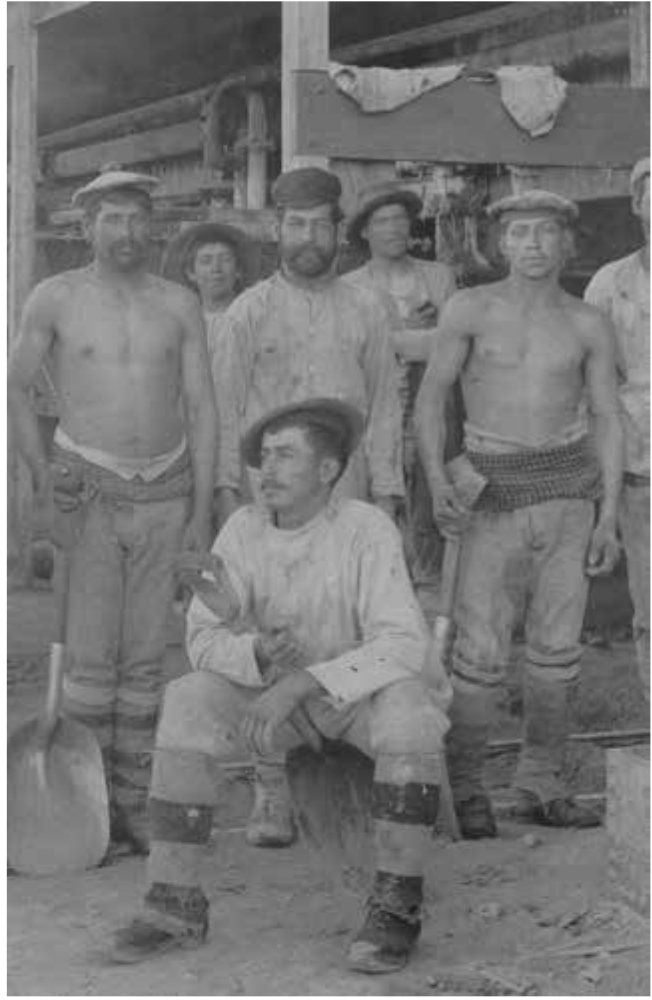
Conclusion
Despite the orderly sequences of productivity and profit revealed by this "album of
views" of the nitrate industry, I have been unable to suppress the "urge to search
[...] for a tiny spark of contingency." There is a tension between the album of industrial
photography and the photographs it contains, or at least one: "A Group of Desripiadores."
They pull in different directions to reveal nothing less than the historical contradictions
of industrial capitalism: pictured here is the inevitable opposition between mining
monopolists and the labor of miners. In the photographed bodies of the ripio workers, we can see both industrial oppression and organised resistance.
The Oficina Alianza and Port of Iquique 1899 album is a document of industrial capitalism. Its long photographic sequence, which
begins with desert rocks and ends with bagged commodities, highlighting the dynamism
of machinery in this material and spatial transformation, is an account of industrial
progress. Its articulation is dependent upon the practice of industrial photography,
Alan Sekula's "characteristic" form of capitalist monopoly. The album Oficina Alianza and Port of Iquique 1899 reproduced a series of scenes of industry that were already established views: the
dramatically altered landscape, the force of machinery, the image of labour obediently
coming to a stop. Plate 27, "A Group of Desripiadores" (Fig. 3), is just another of those "characteristic" forms of industrial photography wherein
the workers' bodily strength stands as part of the documentation of the amassing of
capital. Pasted into the album, their image was transported from Iquique to London,
following the same path as the bountiful bags of nitrate and their detailed account
books, to be received as an analogy of profit: a "handsome volume" that projects a
"handsome result." In the photograph, capital assumes a visual rather than numerical
form. Yet "A Group of Desripiadores" has been retrieved from the hands of monopolist
merchant houses in London through the same process by which it advanced itself: photography.
It is a "dialectical image."23 The light of the Atacama Desert that filtered back through the lens of the camera
to react with the chemical covering of its plate left evidence of the reality of mining
in Chile: the abrasive conditions of shovelling nitrate residue overcome by the collective
strength of those who stood to face the camera and the forces that had brought them
all there. §




















